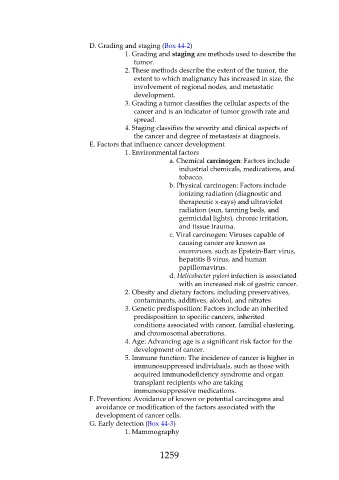Page 1259 - Saunders Comprehensive Review For NCLEX-RN
P. 1259
D. Grading and staging (Box 44-2)
1. Grading and staging are methods used to describe the
tumor.
2. These methods describe the extent of the tumor, the
extent to which malignancy has increased in size, the
involvement of regional nodes, and metastatic
development.
3. Grading a tumor classifies the cellular aspects of the
cancer and is an indicator of tumor growth rate and
spread.
4. Staging classifies the severity and clinical aspects of
the cancer and degree of metastasis at diagnosis.
E. Factors that influence cancer development
1. Environmental factors
a. Chemical carcinogen: Factors include
industrial chemicals, medications, and
tobacco.
b. Physical carcinogen: Factors include
ionizing radiation (diagnostic and
therapeutic x-rays) and ultraviolet
radiation (sun, tanning beds, and
germicidal lights), chronic irritation,
and tissue trauma.
c. Viral carcinogen: Viruses capable of
causing cancer are known as
oncoviruses, such as Epstein-Barr virus,
hepatitis B virus, and human
papillomavirus.
d. Helicobacter pylori infection is associated
with an increased risk of gastric cancer.
2. Obesity and dietary factors, including preservatives,
contaminants, additives, alcohol, and nitrates
3. Genetic predisposition: Factors include an inherited
predisposition to specific cancers, inherited
conditions associated with cancer, familial clustering,
and chromosomal aberrations.
4. Age: Advancing age is a significant risk factor for the
development of cancer.
5. Immune function: The incidence of cancer is higher in
immunosuppressed individuals, such as those with
acquired immunodeficiency syndrome and organ
transplant recipients who are taking
immunosuppressive medications.
F. Prevention: Avoidance of known or potential carcinogens and
avoidance or modification of the factors associated with the
development of cancer cells.
G. Early detection (Box 44-3)
1. Mammography
1259

